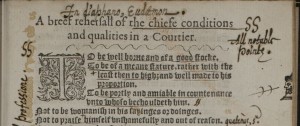Visual marginalia!
On Friday morning, May 1, Matt and I traveled from London to Cambridge to attend the Early Modern Visual Marginalia workshop, organized by Alexander Marr and Kate Isard. This workshop focused on a specific type of marginalia, namely drawings or other forms of visual annotations that early modern readers drew in (or sometimes literally cut and pasted into!) the marginal spaces of their books. Whereas the study of marginalia is extremely fashionable at the moment, most of these studies focus on the more conventional textual marginalia (i.e., written notes), while the visual interventions in early modern books still are understudied. This could very well have been the result of disciplinary boundaries, as the first speaker, Julian Luxford, remarked, as medievalists have been paying close attention to the visual marginalia that appear in medieval manuscripts. Even though visual marginalia are rarer than their textual counterparts, their appearance in early modern printed books warrants careful study.
The morning session of the workshop consisted of several papers all of which dealt with particular aspects of visual marginalia and the sources in which they appear. It soon became apparent how complex these visual marginalia are, as they often involve a combination of text and image, and what a large variety of visual interventions were used by readers, ranging from emblems and architectural drawings to full-fledged mathematical diagrams. Often, like their textual counterparts, visual marginalia refer to objects outside the book in which they were written down or drawn. Whereas Harvey, for example, frequently refers to other books, visual marginalia could refer to a host of material objects that existed outside of the book, including (no longer existing) buildings.

After lunch, we continued with a special session in the Cambridge University Library, where Ed Potten, Head of Rare Books, made available a number of early modern books that included visual marginalia (a number of which were selected by the organizers and several participants of the workshop). All these examples of visual marginalia, especially those in an annotated copy of Johannes de Sacrobosco’s Tractatus de Sphaera, made us realize how complex this form of annotation is and how tricky this is going to be to capture in XML. Currently our schema is poised to deal with the relatively easy drawings made by Gabriel Harvey, who hardly made use of this form of annotation (see the image below for a rare example). We need to think hard about how to incorporate the more complex visual marginalia in our schema as well, especially as we are going to work on John Dee in the next phase of the project.

All in all, this was a very fruitful day, with some thoughtful papers in the morning and the opportunity to browse wonderfully annotated books in the afternoon. Hitherto visual marginalia are a rather neglected form of annotation that deserves much more attention, and hopefully more workshops like these can and will be organized in the future. In the meantime, we will continue to work on refining our XML schema in order to be able to capture more complicated drawings, so stay put for more updates on this topic! Last but not least: massive thanks to the organizers of this wonderful day!
